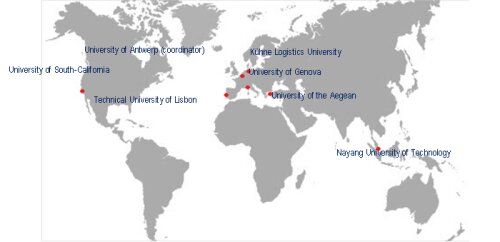Based on the success of 2012 event, University of Antwerp decided to reiterate a new session aiming at explaining How innovation enables to answer the main challenges of the Ports Industry (notably between players of the Supply chain).
Left, you will find more detailed information about the research, the event itself, the deliverables and the press attention.

Following the success of the 2012 event, the University of Antwerp and BNP Paribas Fortis held a second networking event on Thursday 23 April about how key challenges in the port industry can be tackled innovatively.
The idea that the port and maritime sector is less innovative than other sectors can no longer be defended. The fact is that the sector is innovative, but the innovations it produces are not always successful. Some examples illustrate: inland ship with double deck for transport of cars (in the meantime: other destination), indented Berth, allowing (un)loading operations on both sides of the ship, at the Ceres Paragon Terminal in Amsterdam, first prototypes of the foldable container, the innovative airline-style online box-booking ‘youship.com’ of Maersk Line, floating distribution center, harmonization of intermodal containers, internalisation of external costs, etc.
But which conditions need to be met in order for such innovations to be realised successfully? This was the subject of research conducted by the University of Antwerp, in cooperation with a number of university partners around the world, as part of the BNP Paribas Fortis Chair for Transport, Logistics and Ports.
Private operators from ten countries (including IHC Shipyards, DP World Belgium, MSC Belgium, Transport Joosen, Metallo Chimique, Zuidnatie, Wijngaardnatie, ACB group and BCTN) were invited to contribute to the study by sharing and discussing innovative initiatives. This way, the study was able to cover the entire maritime supply chain. In the period 2013-2014, a consortium of seven universities coordinated by the University of Antwerp collected data on 75 port-related innovation cases.
Research
Based on the success of 2012 event, University of Antwerp decided to reiterate a new session aiming at explaining How innovation enables to answer the main challenges of the Ports Industry (notably between players of the Supply chain)
Objective
Understand patterns and characteristics, success factors and failure factors, taking into account the context of the respective challenges which prevailed when they emerged, and the goals they were planned to serve (economic, social and environmental)
Aims
- explain how innovation can answer the main challenges facing the ports industry;
- determine discrepancies in terms of innovation between various regions across the globe;
- test whether innovation success is company-specific or rather context-specific.
- develop indicators of how well the port industry behaves in terms of innovation level, both in time and in comparison to other economic sectors
- check for trends in port-related innovation
Methodology
- Delphi method/H-statistic
- Cost/benefit
- System of innovation approach
- QCA
Industry involved
Port authorities (PT, US) deepsea carriers (SG, IT, BE), deepsea (container, multipurpose,…) terminal (SG, IT, BE), inland barge operator (FR), inland terminal (BE), forwarder (BE), transport company (BE), container sale/lease (NL), shippers (BE), …
Research team
The research is conducted and coordinated by the University of Antwerp, with the involvement of 'partner universities around the world (including members TransportNET), so as to integrate local analysis; as well as the Antwerp Management School.
- University of Antwerp
- Univeristy of Aegean
- University of Genova
- Kühne Logistics University
- University of Lisbon
- Nanyang Technology University
- University of South-California
Deliverables
- Executive summary
- Innovation overview per stakeholder (pdf, 2043KB)
- Innovation in ports - Technology, Information and Processess (e-book, 8MB)
Press releases
- Artikel 'Innoveren om te overleven'
- Artikel 'Innovatie: Wat is de rol van verladers?'
- Artikel "Co-innovation"
- Artikel Flows "Innovatie in havenlogistiek blijkt moeilijke opgave"
- Persbericht Universiteit Antwerpen: “Innovatie verbetert het concurrentievoordeel tussen havens”
- University of Antwerp press release: “Innovation improves ports’ competitive advantage”
- Persberichten BNP Paribas Fortis
- Nederlands:
- English:
- Français: